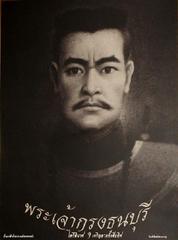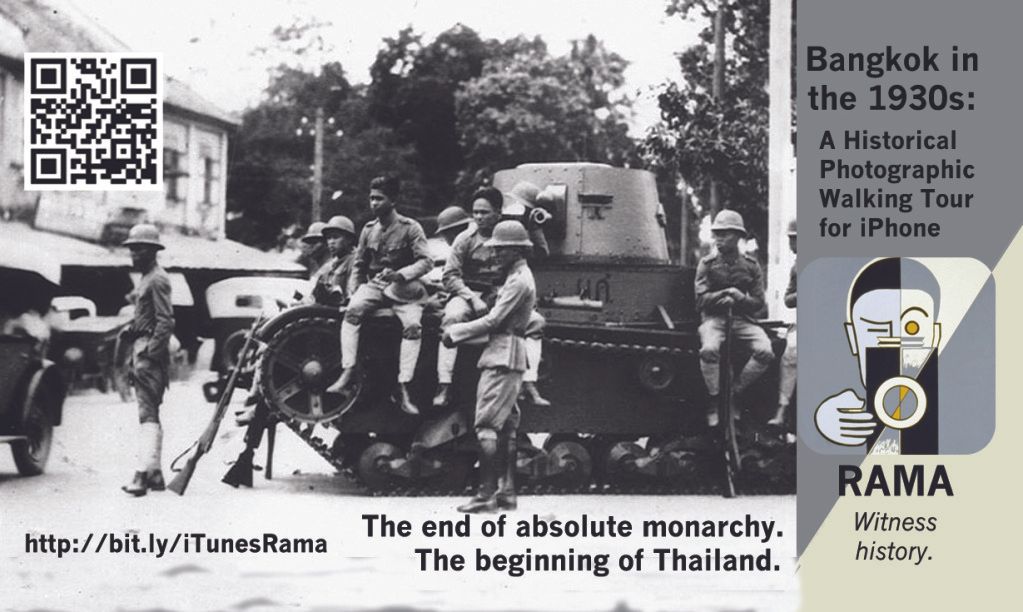The Nine Kings of the Chakri Dynasty: Rama I – The Founding Father
Posted: April 20, 2011 Filed under: History, The Chakri Dynasty | Tags: Ayutthaya, Bangkok, Krung Thep, Rattanakosin Island, Siam, the city of angels, The Grand Palace, Thonburi 3 CommentsBetween Two Kingdoms
After the city of Ayutthaya fell to the Burmese in 1767, Siam went through an itinerant period in which the population was displaced and wealth and resources were lost. The Burmese, confident that they had subdued the Siamese forces, withdrew their main armies back to Burma, and left only a few thousand soldiers under the command of a Mon general. This was a fatal error and their occupation of Siam was to be short-lived. Six months after the Burmese had sacked Ayutthaya, a senior officer from the Ayutthayan army, led 5,000 men and more than a hundred boats to the stronghold at Thonburi. He captured and executed the general in charge then proceeded to make Thonburi his headquarters. Before long, he stood out as a strong leader and sometime in 1768 he was chosen as king by popular consent; his name was Taksin. He ruled Siam in an unorthodox fashion and gained the reputation of being impulsive and short-tempered.
During the reign of King Taksin, two brothers rose to prominence as generals in his army. These two brothers were Bunma and Thong Duang. Bunma had been a close ally of Taksin’s during his military campaigns and it was he who convinced his brother to join Taksin’s army. They both became respected generals and in 1778, Thong Duang led an army to the northeast and invaded Laos. He returned to Thonburi triumphant and brought with him the Emerald Buddha statue. This acquisition undoubtedly increased Thong Duang’s prestige and would have been taken as an auspicious sign for the kingdom. He was later promoted to the rank of Chaophraya Chakri, which would be the equivalent of a modern day Field Marshal.
Taksin became more eccentric towards the end of his reign and when he came into conflict with numerous Buddhist monks, his popularity diminished. This, among other things, planted the seeds of his demise. He was later forced to abdicate and took refuge as a Buddhist monk in Wat Chaeng. A succession struggle ensued in which Thong Duang emerged as the strongest contender for the throne. Once he had asserted his power in the capital, he recalled Taksin from Wat Chaeng and put him on trial to face charges of misconduct. Found guilty, he was beheaded on April 7, 1782.
A New Beginning
Not long after taking command, the new king, who later became Rama I or Phra Buddha Yodfa, distanced himself from the reign of Taksin by reversing a number of his decisions and stressing the dignity of the highest office. Fifteen days after been accepted as Siam’s new ruler, Rama I moved the capital from Thonburi to the east bank of the Chao Phraya River. He established the first city pillar and named the new capital Krung Thep. Only foreigners continued to use the old village name, Bangkok.
Construction of the king’s palace proceeded at a feverish pace and it was decided to model the new city on the old capital – Ayutthaya. It seems the king wanted to regain some of the grandeur of Ayutthaya and perhaps rekindle the flames of a golden age in Siamese history. Whatever the reasons, it is known that Rama I ordered ship-loads of bricks to be brought from Ayutthaya and Thonburi to use as basic building materials for the palaces, fortifications and temples. Whether this decision was made due to economic constraints or for ritual value is impossible to say.
On June 6, 1782, Rama I formally ascended the throne in a traditional ceremony in which monks chanted over a container of water for three days before using it to transform the general into a king. The king was carried by palanquin from Thonburi to Bangkok at an auspicious hour. He was then anointed in his palace and presented with a suitable array of royal names. This marked the beginning of the Chakri dynasty, which the present day monarch, Bhumibol Adulyadej, is descended from.
A Stable Siam
Two years after the king’s ascension to the throne, Bangkok was starting to look like a capital city. An audience hall, library and temple had been constructed within the palace compound and an official opening ceremony was held in which the king was anointed a second time. He developed a daily routine which included giving alms to Buddhist monks, discussing court finances and matters of general importance, and listening to sermons in the audience hall. During his daily meetings, the king would regularly request the Department of Registration to disseminate the royal edict. One of these edicts enforced a law prohibiting civil servants from gambling. In the opening preamble of the edict the state of affairs in Siam is revealed: “Nowadays there are but few amongst the populace who are truthful and who make a living in a law-abiding manner.” Gambling was big business at the time and many people made their fortunes from it. Indeed, Rama I later had to revise the law when it became apparent that State revenue was suffering. He allowed gamblers to continue borrowing money but the license-holders were instructed to lend money based on the means of individuals to avoid excessive debt burden.
Another important reform under Rama I was the revision of the Siamese version of the Buddhist Tripitaka. When the king had been informed that many of the old texts contained mistakes, he organised a council of learned men to edit the extant versions and compile a definitive set. The revisions of the text were finished within five months and a festival was organized to commemorate the new Tripitaka. During the festivities, the roof of the library caught fire as a result of the firework display. Rama I took this as a sign that the old building had not been sufficient and ordered the construction of a sturdier edifice.
With a stable Siam now emerging, Rama I also dedicated some of his time to promoting the arts, particularly the literary arts. Many of the ‘great classics’ were re-written including one of Siam’s best-known tales, Ramakien, which is derived from the Indian Ramayana. The king supervised the rewriting of Ramakien and is believed to have written parts himself. The story of Ramakien is also told in murals on the walls of the Grand Palace.
It was this dedication to the kingdom that helped Rama I to build a strong Siam. His statecraft set the wheels in motion for future kings of Siam, but it wasn’t without opposition and the threat of Burmese invasion was as real as ever.
Conflicting Forces
In the same year that Bangkok was officially opened, King Bodawpaya of Burma, encouraged by numerous military successes, decided to launch an attack on Siam. The Burmese opened five different fronts at strategic locations including Chiang Mai, Petchaburi, the far southern provinces, the Three Pagoda Pass and the town of Tak. The Siamese responded by deploying three forces and Bodawpaya met with the army led by Siam’s uparat (deputy-king), who was none other than Bunma, the king’s brother. At first, the Burmese appeared to have the upper hand, but after food shortages and an outbreak of smallpox, the Siamese sent Bodawpaya and his troops into retreat, harassing them all the way to Burmese territory.
During these battles, the uparat came into conflict with his brother over a request to execute a number of ministers who had failed to fulfill their duties. Because these ministers were close friends of the king, he denied the uparat’s request but gave him permission to punish them. The guilty ministers were stripped of their ranks and their heads were partly shaved before being marched around the camp.
Rama I and his brother were frequently at odds during his reign and feelings of rivalry existed between them. The king had consistently used his power to undermine his brother’s position and towards the end of his life the uparat planned a coup d’état to overthrow Rama I and place his son on the throne. However, he became ill and died before he could carry out his plan. A number of co-conspirators were discovered and executed.
The Legacy
Rama I was born Thong Duang March 20, 1737 to a high-ranking government officer and his Chinese wife. Though he wasn’t born of royal blood, he rose through the ranks and became king of Siam by virtue of his steadfast character, decisive actions and leadership skills. His rise to the throne also fitted the Buddhist belief of karma and his legitimacy depended not on his bloodline but on ties of incarnation. He claimed to be a Bodhisatta, who had attained good karma through merit making in previous lives, and would become a Buddha in his next life.
Rama I was a conservative king, quite the opposite of the eccentric Taksin, and he held the pride of the kingdom above all. Through his numerous reforms, Siam started a new chapter in its history which, though veiled in the guise of orthodoxy, was in fact a time of innovation and would eventually lead to westernization and the fall of the absolute monarchy. He died aged 72 on September 7, 1809. He was the father of some 42 children to 28 mothers; divorce lawyers would have loved this guy.
On his death bed Rama I prophesised that his dynasty would last but 150 years. To find out how that prophecy did (at least in part) come true, stay tuned to this blog as we follow the lives of the Nine Kings of the Chakri Dynasty.






[…] year that Ayutthaya fell to the Burmese. His father was Thong Duang, the man who would later become Rama I. At that time, Thong Duang had been appointed Luang Yokrabat[1] in the provincial town of […]
[…] Bridge) and was built to mark the 150th anniversary of Bangkok. Rama VII ordered a large statue of Rama I to built and placed on the pavilion at the foot of Memorial Bridge. The statue was designed by […]
[…] April of that year, Bangkok celebrated its 150th anniversary. Rama I founded the capital in 1782, after the fall of Ayutthaya. Legend tells how Rama I prophesised that […]